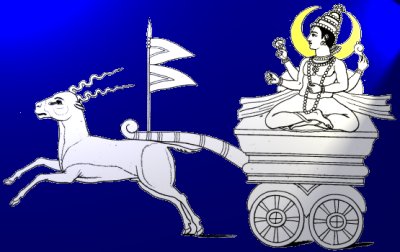



Image from Moor.
Basic Descriptio n: Chandra is the god of the moon. He is seated on the pedestal of lotus placed in a beautiful chariot pulled by seven horses. He is one of the Nine Planets.
Alternate Name s: Kumudapati (Lord of lotus), Mriganga (Spotted), Pavamana (Liqueur purifier), Oshadipati (King of grass), Shivashekara (Crest of Shiva), Sitamarici (With cool rays), Somanatha or Someshwara (Lord of the Soma), Soma.
History/Practi ces: Chandra is an early Vedic God of the Moon. In present Indian Hinduism he is not nearly as highly regarded as he was two to three thousands years ago. Chandra and Soma merged in later Hinduism. Worship of Chandra is beneficial for relief from all sorrows an d helps in curing mental afflictions. It is his cool rays that radiate happiness around. The most effective way to get Chandra to answer one’s prayers is to worship him on Monday. Since t he Hindu name for the day Monday, Somavara, is named after him. Palasa is sacred to him.
Iconog raphy: Chandra is most often shown seated on a lotus in a chariot being drawn either by two antelope or seven white horses. In art Chandra is portrayed as a copper colored man. He has a red banner and rides in a chariot drawn by an antelope.
Mytholo gy: His power is so great that at one point in time even Indra worshipped him. Chandra’s force gave life to all animals, Gods, humans and spirits. The progression from full to half to new moon represents the Gods eating Chandra for his vital energy. But because he is so powerful, even after being completely consumed, he always returns. He has a co-ruler whose name is Candi. She rules the Moon the month after Chandra has been eaten. When Candi is devoured, Chandra returns. Chandra causes nightfall, strengthens the mind, purifies the blood and is the mother who radiates nectar. This nectar is the dew which falls on the plants overnight. Thus Chandra is a fertility god.
Myth concerning Rohini: the other Nakshatras were upset at Chandra’s obvious preference for Rohini so they told their father Daksha. Daksha argued with Chandra and when Chandra refused to repent, cursed him with consumption. Now ailing, Chandra finally repented and after fifteen days Daksha cured him.
Myth concerning Tara: Chandra adored Tara so much that he kidnapped her. For a while he refused to return her, but eventually Brahma convinced him to give her back. When she was returned to Brahmanaspati she was discovered to be pregnant. When the child was born, she named him as Chandra’s child. Brahmanaspati was angered by this and incinerated her, but she was revived by Brahma and once again reunited with Brahmanaspati. After this Brahma forbade Chandra from entering the heavens, thus he has been forced to remain in the sky.
Riding Animal: His vahana (vehicle) is an antelope.
Consort: Candi
Sources:
Moor, Edward. The Hindu Pantheon . Los Angeles: Philosophical research society, 1976.
Thomas, P. Epics, Myths and Legends of India. Bombay, India: D. B. Taraporevala Sons & Co. Private Ltd, 1961.
Return to Table of Contents